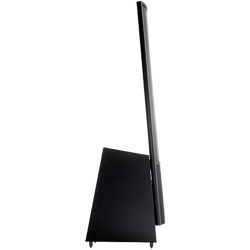Loading ...
Loading ...
Loading ...

11
when toed-in. This design gives you the flexibility to
compensate for a soft or bright room.
Generally it is found that the ideal listening position
is with the speakers slightly toed-in so that you are
listening to the inner third of the curved transducer
section. A simple, yet effective method to achieve
proper toe involves sitting at the listening position,
holding a flashlight under your chin and pointing
it at each speaker. The reflection of the flashlight
should be within the inner third of the panel (see
figure 7).
Imaging
In their final location, your EM-ESL X’s can
have a stage width somewhat wider than the
speakers themselves. On well recorded music,
the instruments can extend beyond the edges of
each speaker (left and right), yet a vocalist should
appear directly in the middle. The size of the
instruments should be neither too large nor too
small, subject to the intent and results of each
unique audio recording.
Additionally, you should find good clues as to
stage depth. Make sure that the vertical alignment,
distance from the front wall, and toe-in is exactly
the same for both speakers. This will greatly
enhance the quality of your imaging.
Bass Response
Your bass response should neither be one note
nor should it be too heavy. It should extend to
the deepest organ passages and yet be tight
and well defined. Kick-drums should be tight and
percussive—string bass notes should be uniform
and consistent throughout the entirety of the run
without booming or thudding.
Tonal Balance
Voices should be natural and full and cymbals
should be detailed and articulate yet not bright
and piercing, pianos should have a nice transient
characteristic and deep tonal registers. This will give
you clues on how to get closer to these ideal virtues.
FINAL PLACEMENT
After the full break in period, obtaining good wall
treatments, and the proper toe-in angle, begin to
experiment with the distance from the wall behind
the speakers Move your speaker slightly forward
into the room. What happened to the bass
response? What happened to the imaging? If the
imaging is more open and spacious and the bass
response is tightened, that is a superior position.
Move the speakers back six inches from the initial
setup position and again listen to the imaging and
bass response. There will be a position where
you will have pinpoint imaging and good bass
response. That position is the point of the optimal
placement from the front wall.
Now experiment with placing the speakers farther
apart. As the speakers are positioned farther apart,
listen again, not so much for bass response but
for stage width and good pinpoint focusing. Your
ideal listening position and speaker position will
be determined by:
• Tightness and extension of bass response
• Width of the stage
• Pinpoint focusing of imaging
Once you have determined the best of all three
of these considerations, you will have your best
speaker location.
THE EXTRA “TWEAK”
This extra “tweak” may be useful when your
speakers are placed in a dedicated listening room.
Use the following procedure and measurements
for your speakers placement to see what can
happen to your system’s performance. These
formulas will help determine optimum placement
of your speakers to minimize standing waves.
Loading ...
Loading ...
Loading ...
